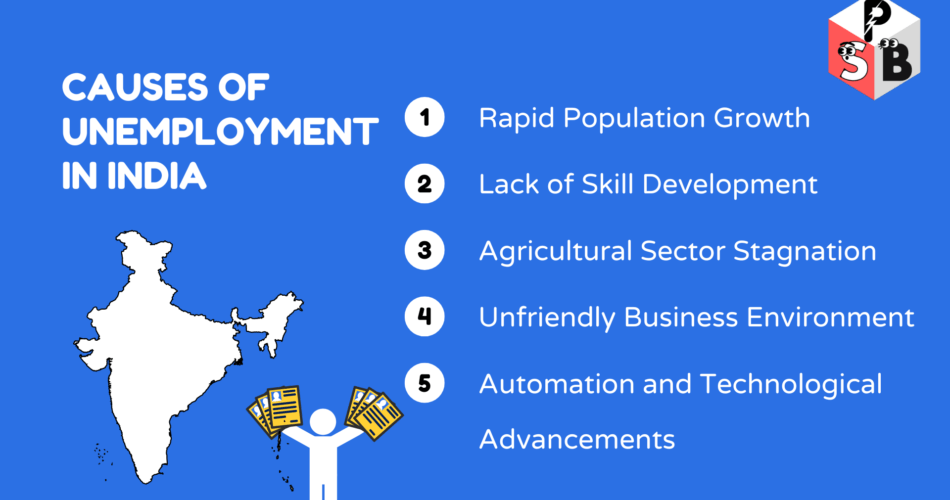Unemployment is a major challenge faced by many countries across the world, and India is no exception. Despite being the world’s fastest-growing major economy, India continues to struggle with unemployment, especially among its youth. In this article, we will explore the various causes of unemployment in India and their impact on the economy.
The 5 main causes of Unemployment in India are as follows:
- The Rapid Population Growth
- Lack of Skill Development
- Agricultural Sectoral Stagnation
- Unfriendly Business Environment
- Automation and Technological Advancements
1. Rapid Population Growth
One of the main causes of unemployment in India is rapid population growth. With more and more people entering the job market each year, it becomes increasingly difficult for the country’s economy to create enough jobs to absorb this growing workforce. In India, the population is projected to reach 1.7 billion by 2050, and this will put a great deal of pressure on the job market.
Way Forward: The government needs to take measures to address this issue, such as providing incentives for companies to invest in the country and creating programs to encourage entrepreneurship.
Initiatives Taken by Govt.- To address the issue of rapid population growth, the government has implemented various family planning and population control programs. Additionally, the government has launched various initiatives to promote entrepreneurship, such as the Startup India program, which provides financial and other support to new businesses.
2. Lack of Skill Development
Another major cause of unemployment in India is the lack of skill development programs. Many of the country’s young people do not have the necessary skills to secure employment in a highly competitive job market. This is due to a lack of investment in education and training programs, as well as a lack of access to job-specific training opportunities.
Way Forward: The government needs to focus on providing quality education and training programs that will equip young people with the skills they need to succeed in the job market.
Initiatives Taken by Govt.- To address the issue of lack of skill development, the government has implemented several programs aimed at improving the quality of education and providing job-specific training to young people. For example, the Pradhan Mantri Ka Saksham Yuva Yojana is a scheme that provides skill training to young people and helps them secure employment. The Skill India Mission is another initiative that aims to train over 400 million people in India in various skills by 2022.
3. Agricultural Sector Stagnation
Agriculture is the backbone of the Indian economy and employs around 50% of the country’s workforce. However, the sector has been stagnating in recent years, leading to a decrease in job opportunities in rural areas. This has resulted in a migration of workers from rural to urban areas, putting even more pressure on the job market.
Way Forward: The government needs to take measures to revitalize the agriculture sector and create new job opportunities in rural areas.
Initiatives Taken by Govt.- To address the issue of agricultural sector stagnation, the government has implemented various initiatives aimed at improving the productivity and competitiveness of the sector. For example, the Pradhan Mantri Fasal Bima Yojana is a scheme that provides insurance coverage to farmers against crop losses. The Pradhan Mantri Krishi Sinchai Yojana is another initiative aimed at improving irrigation facilities in the country.
4. Unfriendly Business Environment
Another cause of unemployment in India is the unfriendly business environment. Many potential investors are deterred by the country’s complex regulations, high taxes, and corruption. This has resulted in a decrease in investment and job creation, making it difficult for young people to secure employment.
Way Forward: The government needs to take steps to simplify regulations, reduce taxes, and tackle corruption in order to create a more attractive environment for businesses to operate in.
Initiatives Taken by Govt.- To address the issue of an unfriendly business environment, the government has taken steps to simplify regulations, reduce taxes, and tackle corruption. For example, the Goods and Services Tax (GST) has simplified the indirect tax system in India, making it easier for businesses to operate. The Insolvency and Bankruptcy Code has also been introduced to streamline the process of resolving insolvency and promote ease of doing business.
5. Automation and Technological Advancements
Technological advancements and automation are also contributing to unemployment in India. As machines and robots become more advanced, they are replacing human workers in many industries, resulting in job losses. This is particularly true in the manufacturing sector, where automation has led to a decrease in the number of jobs available.
Way Forward: The government needs to invest in programs that will equip workers with the skills they need to adapt to the changing job market and take advantage of new job opportunities created by technological advancements.
Initiatives Taken by Govt.- To address the issue of automation and technological advancements, the government has launched various initiatives aimed at equipping workers with the skills they need to adapt to the changing job market. For example, the National Policy on Skill Development and Entrepreneurship aims to provide skill training to workers and help them secure employment in the changing job market. The Digital India initiative aims to promote the use of technology in various sectors, such as healthcare and education, and create job opportunities in these sectors.
Bottom Line
In conclusion, unemployment is a major challenge faced by India, and it is caused by a combination of factors, including rapid population growth, lack of skill development, agricultural sector stagnation, an unfriendly business environment, and automation and technological advancements. The government needs to take measures to address these issues, such as investing in education and training programs, revitalizing the agriculture sector, simplifying regulations, reducing taxes, and tackling corruption. By doing so, it will be possible to create a more attractive environment for businesses to operate in and to provide young people with the opportunities they need to secure employment and build a better future for themselves and their families.

